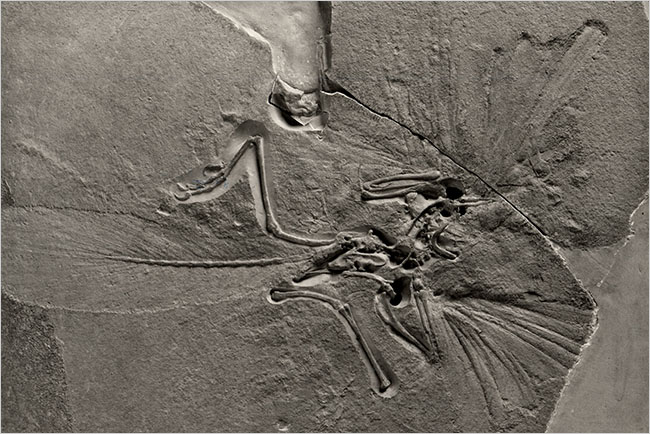New York Times: Paper Challenges Ideas About ‘Early Bird’ Dinosaur
The first fossil of the raven-size species was an immediate sensation when it was excavated in 1860, in southern Germany. It had feathers and a wishbone, like birds, but teeth and a long, bony tail, like reptiles. Coming the year after publication of “The Origin of Species,” the discovery swayed many scientists into accepting Darwin’s theory of evolution by natural selection.
Thomas Henry Huxley, Darwin’s staunch ally, recognized the fossil in a limestone slab as a transitional species between dinosaurs and birds. Over time, the 10 known specimens of Archaeopteryx became widely regarded as examples of the earliest bird, which lived about 150 million years ago.
Now scientists examining tiny pieces of a specimen’s long bone under powerful microscopes for the first time said they found unexpected patterns indicating that the species grew at a rate faster than living reptiles but only one-third as fast as that of modern birds. The evidence, they reported Thursday, challenges the hypothesis that Archaeopteryx had already developed characteristics of a physiologically modern bird.
In a research paper being published in the online journal PLoS One, the science team led by Gregory M. Erickson, a paleontologist at Florida State University, concluded that Archaeopteryx was simply a feathered dinosaur that might have been capable of some aerial behavior, though perhaps not powered flight. In short, despite feathers, it was not the archetypal bird.

Scientists who examined pieces of fossil bone concluded that Archaeopteryx was a dinosaur.
Dr. Erickson said in an interview that studied under a polarizing microscope, the dense microstructure of the bone showed few traces of blood vessels. He said this was evidence of a slow metabolism by which the individual probably took more than two years to reach adult size. Birds have especially fast metabolisms, making them able to leave the nest in days or a few weeks.
Mark A. Norell, a co-author who specializes in dinosaur research at the American Museum of Natural History in New York, said the findings showed that “the transition to physiological and metabolic birds happened well after Archaeopteryx.” As a result, he added, the evolutionary emergence of birds “is still a huge mystery.”
Both Dr. Norell and Dr. Erickson emphasized that their findings did not undermine the theory widely held among paleontologists that birds evolved from what are known as theropod dinosaurs. Birds, in that sense, are avian dinosaurs, although some ornithologists insist that is a stretch.
Paleontologists and ornithologists who had no part in the research said the findings were an important step in dinosaur-bird studies, but not surprising.
“Archaeopteryx has always been seen as a marvelous example of a transitional species,” said Helen James, an ornithologist at the National Museum of Natural History in Washington. “You would expect to find its physiology to be transitional from what we see in modern birds and modern reptiles.”
Lawrence M. Witmer, a paleontologist at Ohio University who conducts other Archaeopteryx research, said that he was not surprised to learn that the species was “not fully avian,” but that it had many features seen in later birds, indicating that it had not been displaced as “a very basal member” of the avian family tree.
In the new research, the scientists worked with Zhonghe Zhou of the Institute of Vertebrate Paleontology and Paleoanthropology in Beijing, conducting similar bone examinations on several specimens found recently in China of feathered dinosaur species. They concluded that confuciusornis was the first known species in which the transition to a bird’s growth rate occurred.
Confuciusornis lived about 130 million years ago. Although its growth rate was somewhat slower than that of most same-size living birds, this species had no teeth, no long tail and seemed to grow more rapidly than Archaeopteryx and other known specimens in between. More advanced bird fossils, with bones well supplied with blood vessels, appeared somewhat less than 100 million years ago.
In fact, it was the numerous discoveries in China that prompted the first close examination of Archaeopteryx bones. Two years ago, Oliver W. M. Rauhut of the Bavarian State Collection for Paleontology and Geology in Munich gave the scientists permission to conduct the research on the museum’s fossil, which like all the known specimens was of a juvenile.
Museum technicians extracted samples — hardly larger than specks of lint — from already damaged parts of a thighbone.
The bone growth rate, the scientists determined, was unbirdlike but reflected metabolic rates greater than those in nondinosaurian reptiles; that is, they were more warmblooded than coldblooded. In that respect, Archaeopteryx appeared to be intermediate between reptiles and birds, growing at a probable rate close to that of marsupials, they said. Comparisons with other birdlike dinosaur specimens indicated that the bone structure of this Archaeopteryx was not abnormal.
“Theories regarding the subsequent steps that lead to the modern avian condition need to be re-evaluated,” the scientists concluded in the journal article, “to help understand what is turning out to be a complex evolutionary story.”
Download attachments:


